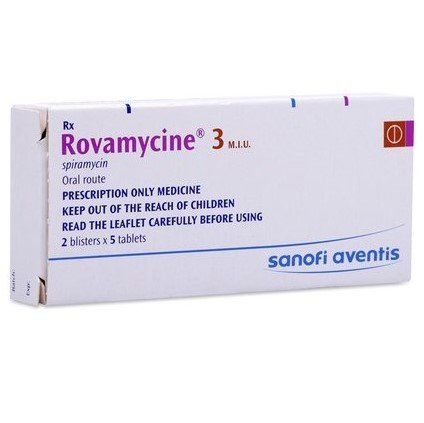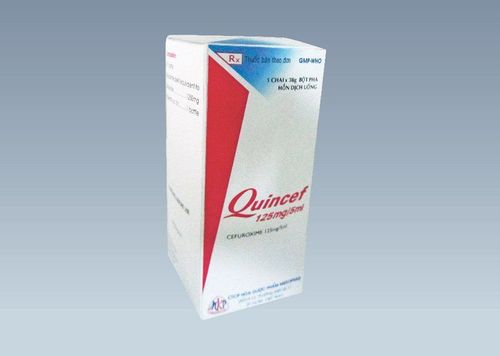This is an automatically translated article.
Klamentin 625mg is a combination antibiotic between amoxicillin and clavulanic acid. The drug is indicated in the short-term treatment of upper and lower respiratory tract infections, soft tissue infections, skin infections, urinary tract infections... Let's learn about the uses and dosage of Klamentin 625mg through the article below. this.
1. Uses of Klamentin 625 mg
1.1. Indications Klamentin 625mg contains active ingredients Amoxicillin and clavulanic acid in the ratio 500/125. The drug is indicated in the short-term treatment of bacterial infections in children and adults as follows:
Upper and lower respiratory tract infections: Exacerbation of chronic bronchitis, acute otitis media, sinusitis, inflammation community-acquired lung. ..; Inflammation of the urinary tract: pyelonephritis, cystitis; Skin and soft tissue infections such as wound infections, boils; Bone and joint infections such as osteomyelitis. The drug is bactericidal in many types of bacteria, including beta-lactamase-producing bacteria resistant to amoxicillin and ampicillin.
1.2. Pharmacodynamics Active ingredient Amoxicillin belongs to the group of semi-synthetic penicillin antibiotics, has a broad bactericidal spectrum against many Gram-positive and Gram-negative bacteria by inhibiting bacterial cell wall synthesis. However, Amoxicillin is easily destroyed by Beta-lactamase, so the drug has no effect on bacterial strains that produce these enzymes.
Clavulanic acid has a beta-lactam structure similar to penicillin and the drug has the ability to inhibit beta-lactamse caused by Gram-negative bacteria and Staphylococcus bacteria. In particular, clavulanic acid strongly inhibits plasmid-transmitted beta-lactamases that cause resistance to cephalosporins and penicillins. The combination of amoxicillin and clavulanic acid in Klamentin prevents the antibiotic amoxicillin from being destroyed by beta-lactamases, and effectively extends the antibacterial spectrum of the drug against many bacteria normally resistant to amoxicillin, penicillins and cephalosporins.
1.3. Pharmacokinetics Both amoxicillin and clavulanic acid are well absorbed from the oral route. The maximum concentration of the drug is reached in the serum after about 1-2 hours. Absorption is not affected by food, so it is best to take it right before a meal. The oral bioavailability of clavulanic acid is 75% and amoxicillin is 90%. The half-life (t1/2) of amoxicillin in serum is 1 to 2 hours and about 1.5 hours for clavulanic acid. Approximately 55-70% of the amoxicillin and 30-40% of the clavulanide acid are excreted in the urine as active form. Concomitant administration of probenecid prolongs the elimination time of amoxicillin but does not affect the elimination of clavulanic acid.
2. Dosage of Klamentin 625 mg
Dosage of Klamentin 625mg is calculated according to the antibiotic amoxicillin. The drug should be taken immediately before meals to help minimize the phenomenon of drug intolerance in the gastrointestinal tract. Dosage recommendations are as follows:
Adults and children over 12 years old: Take 1 tablet x 2 times/day in case of mild infections and take 1 tablet x 3 times/day in case of infections. heavy; In case of patients with renal failure, the dose should be adjusted accordingly; The duration of treatment with Klamentin 625mg should last from 5 to 10 days. Note that the course of drug treatment should not last more than 14 days without re-examination.
3. Side effects of Klamentin 625 mg
Some side effects may be encountered when using Klamentin 625mg as follows:
Common effects: Nausea, vomiting, diarrhea; Uncommon side effects: Hepatitis, eosinophilia, cholestatic jaundice, erythema, pruritus, rash; Rare side effects: Thrombocytopenia, anaphylactic reactions, hemolytic anemia, leukopenia, pseudomembranous colitis, interstitial nephritis, Stevens-Johnson syndrome. In case of experiencing side effects, the patient should stop taking the drug and immediately notify the doctor or go to medical facilities for timely treatment.
4. Notes when using Klamentin 625 mg
4.1. Contraindications Contraindications to the use of Klamentin 625mg in the following cases:
Patients are sensitive to any component of the drug Klamentin 625mg; People with liver failure, severe kidney failure; People with a history of jaundice or liver dysfunction when taking penicillin antibiotics; Infectious mononucleosis. 4.2. Precautions for use Anaphylaxis and potentially fatal hypersensitivity reactions have been reported with the drug, especially in patients with a history of hypersensitivity to penicillins. Therefore, it is necessary to report to the doctor in case of a history of allergy to penicillins, cephalosporins or other drugs before treatment with Klamentin.
Patients with severe renal impairment should have the dose of Klamentin adjusted. Use with caution in the elderly, patients with a history of jaundice or liver dysfunction due to amoxicillin/clavulanic acid, because the risk of intrahepatic cholestasis is increased. Drug-induced cholestatic jaundice is usually severe, but rare, and reversible after several weeks of discontinuation of drug therapy.
Patients should be carefully monitored when Amoxicillin/clavulanic acid is used concomitantly with oral anticoagulants. Because they can cause abnormal prolongation of prothrombin time (increased INR). In some cases, it may be necessary to adjust the dose of the anticoagulant to maintain the desired level of effect.
Patients need to periodically check liver function, kidney function and hematology index during the course of treatment. Prolonged treatment with Klamentin may cause superinfection.
Although, the rate is very low, there have been reports of amoxicillin crystals in urine in patients with decreased urinary excretion, mainly encountered when using amoxicillin infusion. Therefore, patients need to drink enough water to be able to maintain urine output during treatment with high doses of amoxicillin.
Pregnant women: There are no studies demonstrating the ability of Klamentin to cross the placenta and cause harm to the fetus of Klamentin. However, to ensure safety, use the drug in pregnant women only when absolutely necessary. Lactation: The drug is excreted in breast milk, so caution should be exercised when using the drug in this subject. Driving, operating machinery: Klamentin 625mg can cause side effects such as headache, dizziness, so caution should be exercised when driving, operating machinery, people working at height...
5. Drug Interactions Klamentin 625 mg
Klamentin 625mg drug may cause interactions with some of the following drugs:
Probenecid reduces the renal tubular secretion of amoxicillin, increasing the concentration of amoxicillin in the blood; Klamentin can cause prolongation of blood clotting time and bleeding, so it should be used with caution in patients being treated with anticoagulants such as warfarin; The drug inhibits the renal tubular secretion of methotrexate, thereby increasing the hematological toxicity of methotrexate; Klamentin reduces the effect of oral contraceptives; Concomitant use of amoxicillin and allopurinol may increase allergic skin reactions; The active ingredient amoxicillin in the medicine can affect the results of the test for glucose in the urine. Klamentin 625mg is an antibiotic combination of amoxicillin and clavulanic acid. The drug is indicated for the short-term treatment of upper and lower respiratory tract infections, soft tissue infections, skin infections, urinary tract infections. To ensure effective use and avoid unwanted side effects, patients need to take the drug according to the prescription or consult a doctor, professional pharmacist.
Follow Vinmec International General Hospital website to get more health, nutrition and beauty information to protect the health of yourself and your loved ones in your family.
Please dial HOTLINE for more information or register for an appointment HERE. Download MyVinmec app to make appointments faster and to manage your bookings easily.













